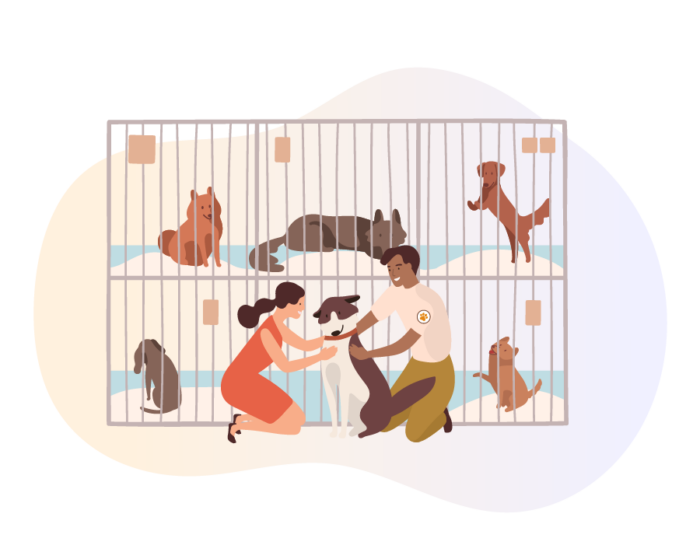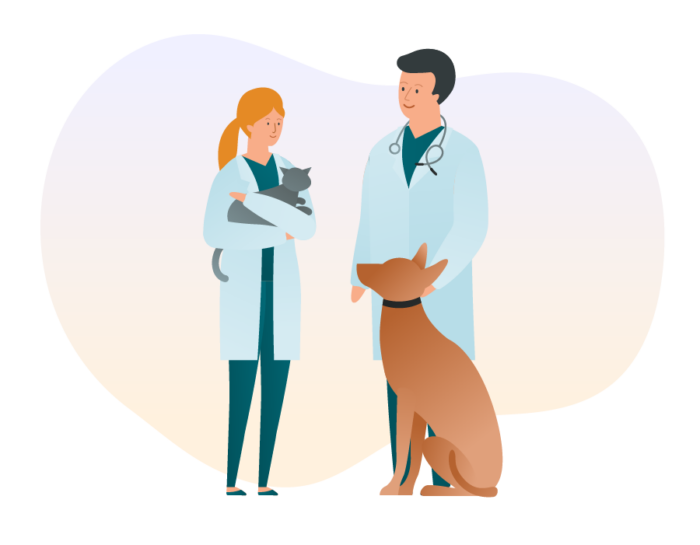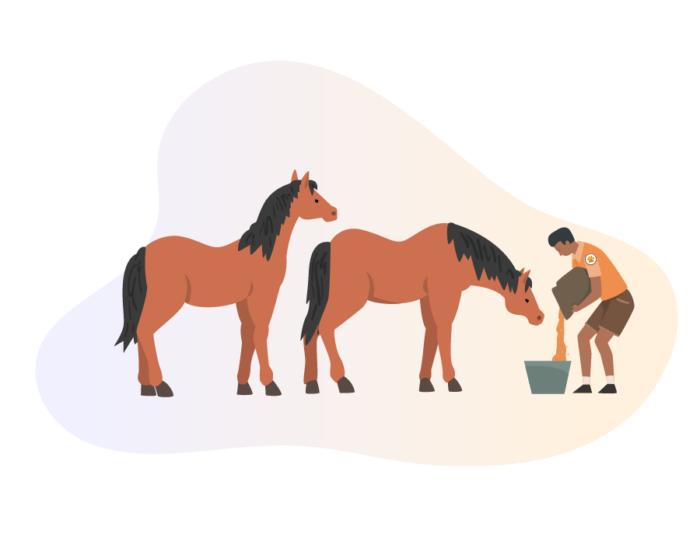So you want to start an animal rescue. Bravo! Our lovable, furry friends need more compassionate people like you who want to help them. There are lots of animals in need and a limited number of ready and willing rescuers, which means your efforts will be much appreciated.
However, if you want to start out strong and stay in it for the long haul, you’re going to need guidance. That’s why we put together this informative guide chock-full of advice straight from the experts — people who have either founded an animal rescue or shelter of their own or have worked for one for many years.
Follow these steps when starting your animal rescue:
- Make sure that running an animal rescue is the right thing for you. Animal care requires too much time, effort, and sacrifice if it isn’t your passion.
- Prepare a business plan. Even though most animal rescues are nonprofits, you’ll still need to cover expenses.
- Prepare appropriate facilities and equipment.
- Find volunteers and hire the right people. You’ll need at least several dedicated volunteers and one vet.
- Launch a website and create social media accounts. This will make it easier to collect donations and to find people who want to adopt an animal.
- Build a supportive network. Form relationships with other shelters and people involved in animal welfare in your area.
- Hold regular events to raise awareness and funds.
Chapter synopsis of the guide
This guide consists of nine chapters, which you can easily navigate to at any time.
- Introduction
- Is starting an animal rescue right for you? Passion fuels the decision to start an animal rescue, but you also need to be aware of certain realities before jumping in. Our animal rescue guides provide a useful reality check.
- Animal rescue vs animal shelter. Learn the difference between an animal rescue and an animal shelter.
- Managing an animal rescue. There are a lot of moving parts in an animal rescue. Get an in-depth look at each of them here.
- Animal adoption. Here’s how animal adoption works and what you should look out for.
- Finding volunteers. You need volunteers to run a successful animal rescue. Here’s how to find them.
- Job duties. What do rescue volunteers and staff actually do all day? Here’s the answer.
- Fundraising. Despite the name, fundraising isn’t always exciting, but it is necessary. We explore several ways you can get money for your shelter while keeping things interesting.
- Forms made easy with JotForm. The rescue business is full of forms, which can strain your already limited time. We explore how Jotform gives you some of that time back.
Remember to bookmark this guide. The journey to starting and running an animal rescue is a long one. You’ll need to reference the points and guidance below many, many times. Now, go forth and explore!
Is starting an animal rescue right for you?
“An animal rescue is a wonderful thing for animals, and it’s incredibly rewarding for the people involved. But it’s not all peaches and cream,” cautions Eleanor Monfett, shelter manager for Saugerties Animal Shelter.
And she’s absolutely right. Your love and passion for animal welfare and safety may inspire you to start an animal rescue or shelter, but it takes a lot more to get the operation up and running—and sustain it over the long term.
Some practical aspects you may not have considered
It’s a demanding job that may infringe on personal time
Taking care of even one animal is a 24-7 job. Owners often compare having pets to having children because they are all living, breathing creatures that need care, nurturing, attention, and time. Lots and lots of time. A running joke with pet owners is that the only difference between the two is you’re allowed to leave the pet at home alone sometimes.
But that’s just one animal. Imagine having to care for 10 or 100. Even if you manage to get help — and you’ll definitely have to — you still must commit a large share of your personal time to your animal rescue business.
“Unlike most jobs, even when you’re off, you’re not really off,” says Maria Gillinson, founder of Central Ontario Animal Rescue (COAR). “There’s always a dog, a cat, or a person that needs something from you. For example, I was watching TV at home with my husband in the evening, and a veterinarian called needing care input on one of my recent rescue dogs. I couldn’t just tell him I’d call back the next day because that poor pup couldn’t wait. So I took the time and answered the vet’s questions. I gladly accept those interruptions, of course, but it’s something you have to consider.”
It takes an emotional toll
Love may be the primary emotion you associate with animals, but running an animal rescue business invites several other emotions, and not all are positive. You’re bound to be happy, sad, angry, frustrated, overjoyed, and confused — and that’s just the first hour of the day!
The joy of rescuing an animal and matching it with the perfect family can make your day. But that doesn’t happen overnight. For some dogs and cats, it takes months (or longer) to get adopted.
In addition, many animals have endured difficult circumstances and may be malnourished, neglected, have a medical condition, or worse. Seeing animals face these and other challenges can be hard, especially if the owner is at fault.
“It’s so difficult when you see a malnourished puppy being surrendered by an owner. You have to ignore how you feel, remain professional, and get all the information you can about the pup’s situation and why it is being surrendered. After all, the pup’s well-being must come first,” notes Gillinson.
Just so you know
Ready to launch your animal rescue? Get started with Jotform’s free adoption forms, volunteer applications, donation forms, and more!
It requires some degree of business savvy
Getting any business off the ground often requires bootstrapping — using your personal funds to cover business needs. Starting an animal rescue is no different.
The more you want to help, the more you’ll wind up pouring into the business. That’s not a problem if you have the funds to spare, but if you’re like many would-be rescuers, you’ve got more heart than cash. This makes donations (which we’ll explore later) critical; having business acumen makes fundraising and managing your rescue easier.
“Like many new things in life, you have to walk before you run. Ask yourself, ‘What do I have the means to do, realistically?’ ” advises Debbie Howell, board president for the Humane Society of Pulaski County. “If you want to run a big rescue or shelter, complete with a big building and a large team of volunteers, that’s great! But you can’t make that a reality for Monday morning. Start small and work your way up.”
Remember the importance of profitability (despite being a nonprofit)
The one practical concern you’ve undoubtedly considered is going the nonprofit route. Obtaining 501(c)(3) nonprofit status for your animal rescue business is essential to long-term viability. Without it, you’ll find it extremely difficult to fundraise since many states require the designation to accept donations.
However, your nonprofit status does not mean profitability is no longer a concern. Being profitable enables you to
- Rescue and care for more animals. It takes a lot to transport, treat, house, and feed those adorable dogs and cats. Vet bills can be expensive!
- Handle the upkeep and maintenance of a building. Not all rescues have a physical location — opting for a foster network instead — but for larger ones that do, fixed and variable costs can quickly overwhelm the unprepared.
- Gain visibility. Marketing and public relations can make a huge impact on your rescue by raising awareness in the local community (and beyond), but these activities require financial funding. The more people who know about your rescue, the more donors you can find and the more animals you can help.
Starting an animal rescue business is obviously a big decision, but if you’re still gung-ho about moving forward (and hopefully you are), that’s great! Read on to learn about key aspects of starting an animal rescue to make your efforts a raving success.
Animal rescue vs animal shelter
The terms animal rescue and animal shelter are often used synonymously. That’s not surprising given how much they have in common. However, each type of business has distinctive characteristics.
How animal rescues and animal shelters are similar
Both animal rescues and animal shelters
- Take in and care for animals that come from a variety of different situations, such as owner surrenders, strays, and transfers from other rescues or shelters
- Focus on getting animals adopted to suitable homes as soon as possible
- Cover animal and business expenses, such as vet bills, transportation fees, staff compensation, building upkeep, rent or mortgage, training fees, and an array of animal care costs
- Rely heavily on donations to cover seemingly endless costs
- Need dedicated, reliable volunteers to handle the numerous tasks — feeding, walking, event setup, etc. — that ensure their animals are ready for adoption
- Strive to provide a stable environment and suitable care for animals with the often-limited funds they have available
Just so you know
Jotform offers free, customizable form templates for both animal rescues and shelters. Sign up for free to create your animal shelter or rescue form today.
How animal rescues and animal shelters are different
Rescues and shelters differ mostly in how they operate and their perspective when it comes to animal welfare. Below are the most prominent distinctions.
How they are governed
Rescues are almost exclusively private ventures, which means owners don’t answer to anyone but themselves (unless it’s a legal matter). In contrast, animal shelters are more often than not government-run (and -funded) facilities that are part of the public sector. This impacts multiple aspects of the shelter — including its mission, operations, and decision making — as there is a lot more oversight and bureaucracy involved.
Mission
Every rescue or shelter has a mission, even if it isn’t formally stated. However, the perspective of the mission differs.
Rescue mission statements tend to focus on animal care and safety, finding animals good homes, and ensuring their overall well-being.
For example, Gillinson’s mission for COAR is to save dogs from high-kill shelters. “We of course want to save dogs from any situation, but we also recognize that shelters are often overwhelmed by too many dogs and are forced to euthanize due to space issues. We want to lighten that load and find these dogs a good home. They deserve it.”
Government-run shelters, on the other hand, have more of a civic focus, being primarily concerned with public safety and secondarily with animal welfare. But not every shelter follows suit:
“Our shelter is a bit different than the standard. Most shelters have a mission mandated by the local government since it funds their operations. However, we’re privately run, so our mission is more in line with a rescue — animal safety and care come first every time,” Howell says.
Control over operations
Rescues have a lot more control over things like adoption fees and operating hours. They also may choose to specialize in a specific type of animal or even breed. For example, there are rescues that save only dogs or cats; some have an even more specific focus on schnauzer or boxer breeds (for dogs), or Bengal or Persian breeds (for cats).
Shelters have set fees and hours, among other operating aspects mandated by the government. They also don’t have specializations, except for possibly accepting only household animals, such as dogs and cats. This helps reduce owner abandonment and control the stray population, both of which impact the local community.
Fostering
While both rescues and shelters use a foster network, rescues are much more dependent upon foster volunteers to give dogs and cats a safe and stable environment. This is mainly because many rescues do not have a formal space, such as a leased building or purchased property, to house animals. (Or the space they do have is very limited, allowing for only a handful of animals at a time.)
Meanwhile, shelters typically have enough property to house 100 to 200 (or more) animals, even though they also often lack sufficient space for the number of animals present. This then necessitates either turning to foster families or, unfortunately, euthanasia.
Whether rescue or shelter, check out Jotform’s templates that make collecting donations and adoption submissions super easy.
| How animal sanctuaries diverge from rescues and shelters: Unlike animal rescues or animal shelters, animal sanctuaries operate within an entirely different context. Their main goal is not to adopt pets but to provide a permanent home for animals, allowing them to live out their days in peace and safety. (Note that there are some sanctuaries that allow adoptions.) Their animal roster typically includes all types of animals, such as dogs, cats, horses, rabbits, goats, and more. Sanctuaries focus on improving the quality of life for these animals, including enrichment programs that include both inside and outside activities. A sanctuary may be different in concept from rescues and shelters, but starting and running a sanctuary requires the same level of dedication and effort. Make sure you have a clear mission and a good understanding of what’s required before you get started. Now that you understand the distinction between animal rescues and animal shelters, it’s time to dive into the nitty-gritty of animal rescue operations. |
|---|
Managing an animal rescue
Starting an animal rescue may seem like an easy thing to do — just put up a few puppies and kittens temporarily, right? If only things were that simple.
“It’s super rough in the beginning,” Howell says. “You’re dealing with things you’ve never dealt with before, like never-ending expenses and legal concerns, and you’re learning as you go to make sure the animals are taken care of. It doesn’t stop there, either.”
“You have to keep rolling with the punches. Having worked with this shelter for over 15 years, I can tell you that even now we face challenges. Their type and scope have evolved, but challenges are always there. ”
“Beyond the daily operations, keeping a cool head and remembering why you’re doing this are two important lessons you learn very quickly.”
Once you’ve started your rescue, you have to manage it. Below are several key operational areas you’ll deal with from day to day.
Just so you know
Manage records, volunteers, and more for your animal rescue with our free customizable form templates designed to meet your needs.
Be prepared for the costs
Even when you’re just beginning your rescue journey, the costs can hit you like a ton of bricks if you’re not ready for them. If you want to rescue animals over the long term, make sure you’re aware of the many expenses you’ll incur.
Veterinarian bills
Topping the cost list for any animal-related organization is the vet. Microchipping, spaying/neutering, testing, and vaccinating are examples of less pricey services; unfortunately, some animals have bigger health issues. Rabies, dental problems, and broken bones are all problems that can push the veterinary bill close to or into the thousands.
“A single pup that needs surgery can wipe out all the donations you received last week,” notes Monfett.
That’s why it’s important to connect with local vets as soon as possible during your startup phase to build a good relationship. You always want to have a vet or two you can call on to help a sick pup or kitten, especially outside of normal business hours. In some cases, a generous vet may even provide your rescue with a small discount (sometimes 10 percent) on services.
“Every little bit helps when you have limited funds,” Monfett says.
Supplies
“Food, food, and more food. We buy it and we get it donated, but we always need more. There are always so many hungry mouths to feed,” says Howell.
And it’s not just the amount of food needed. Given that puppies and kittens need food fit for their age range, rescues and shelters need different types of food as well.
In addition to food, there are a number of other items crucial to animal care:
- Disposable bags
- Kitty litter
- Cleaning supplies
- Collars and leashes
- Grooming products
- Kennels
- Beds
- First aid supplies
- Toys
Transportation
Whether it’s across town, across state lines, or across country borders, transporting animals can be costly. The why behind a transport may vary, but one common reason is overpopulation. One shelter may have more dogs or cats than it can handle and will need to send several of them to another shelter or rescue that has the room (and is willing to accept new animals).
If your rescue isn’t big enough to have a dedicated transporter, you may have to hire a transporter when needed, as Gillinson does. “We often have to engage with a transporter to transport dogs from Buffalo, or to transport a dog from a shelter to a foster family’s home. This can run anywhere from $125 to $350, which adds up quickly if multiple transports are needed in the same month.”
Staff compensation
While not all rescues or shelters employ staff, some — typically the larger ones — do. Those shelters benefit from having dedicated individuals and consistent help, instead of having to rely solely on volunteers.
“We love our volunteers, but we realize they have work and lives of their own that sometimes pull them away from the shelter. That’s why our core group of employees is so important. I know I can count on them to be here, giving our animals the care they need consistently. That peace of mind is definitely worth the additional expense,” Howell says.
Building and property upkeep
Many rescues will never purchase or lease a physical property to house animals, but for those that do, the upkeep can be expensive. Like any property, you have to care for it, and that includes items such as
- Rent or mortgage payments
- Utility payments
- Cage/kennel repair
- Groundskeeping and landscaping
- Building maintenance (e.g., air-conditioner, heater, general repairs, etc.)
Get legal, quickly
Like any business, your rescue needs to approach the work it does legally. That means taking the necessary steps in the beginning to establish your rescue as a 501(c)(3) nonprofit organization. You’ll need to register with your state, making sure to follow its guidelines and requirements. You’ll also need to file accordingly with the IRS to recognize your exempt status.
Legality doesn’t stop there. Depending on your state’s laws, if you engage an animal transporter, they may need to be registered as a rescue or be legally bound to a rescue.
There are also lots of contracts, forms, NDAs, and other legal documents — for adoptions, surrenders, fosters, volunteers, transporters, rescue-to-rescue partnerships, and more. “Everything needs a form!” declares Drea Rose, longtime volunteer of Gillinson’s COAR.
“They may seem cumbersome when you just want to focus on finding your animals a good home, but these legal devices are important. I need to know that the dog I release to an adopter will really take care of it, regardless of their own life situation. For example, if I have a couple that adopts one of my dogs, I want to know who will care for it if they ever separate. And I’ll spell that out clearly on the dog adoption form. The welfare of the pet always comes first in my book,” explains Gillinson.
Location, location, location
It’s an old real estate saying that’s just as applicable in animal welfare. Assuming you have a physical space, the location of your rescue or shelter is important. You need to be visible to your local community, so people know where you are and where to go when surrendering or adopting an animal.
“It’s really important when you’re first starting out to be highly visible or in a populated area. You’ll get more foot traffic that way, which cuts down on things like marketing and advertising costs that are meant to gain attention. This also helps establish your reputation,” notes Monfett.
Handle owner surrenders appropriately
Owner surrenders can be complex and emotionally charged situations. You should always approach them with tact and care to avoid making the owner feel uncomfortable.
“There’s a delicate balance you must maintain. You need to get enough information about the animal and its situation, but you don’t want to pry too much and risk scaring the owner away, because they may seek an alternative path that puts the animal in a worse situation,” cautions Gillinson.
Here are a few steps you can take to ensure a successful surrender:
- Interview the owner via phone or in person to find out the animal’s disposition, temperament, medical situation, and relationship with the owner. Also, confirm ownership and identify why the owner is surrendering the animal. Get as many details as possible, as these will help with placing the animal later.
- Probe for any potential issues, such as the animal not getting along well with children, whether it’s bitten anyone, and whether it’s been abused or neglected.
- Examine the animal in person (if feasible), then decide whether to take the animal based on everything you’ve learned. For example, you may choose not to accept the animal if it is overly aggressive and could present a danger to other animals or volunteers. If you are unable or unwilling to take the animal, give the owner other resources or avenues they can pursue to ensure the animal is cared for properly.
- If you are willing to take the animal, have the owner fill out a surrender form to relinquish ownership of the animal. Be sure the owner understands they are giving up their ownership rights and cannot take the animal back. Jotform has a great owner surrender form template that will make the transition from owner interview to owner surrender seamless.
Give animals adequate housing and recreation
Housing requirements for animals vary from state to state, but here are a few guidelines (mainly for dogs):
- Cages, kennels, or other enclosures should be large enough for the dog to sit, stand, stretch, turn around, and move its head without touching the top of the enclosure. Ideally, the kennel should provide ample breathing room, allow the dog to take several steps freely, and include a separate partition or area for it to eliminate. Other items like a bed and elevated food and water dishes also help.
- Animals should be separated according to things like age, sex, and health status to maintain good physical and psychological health for the shelter inhabitants overall.
- Indoor and outdoor runs should be large and long enough to accommodate one or two dogs running at a time. Ideally, the runs should allow for multiple dogs running back and forth and be able to withstand regular use over the long term.
For other guidelines, you can refer to this ASPCA article and webinar on the subject.
Be social
Social media offers those in the animal welfare community a number of great channels to help grow and improve their rescue businesses. For example, you can use social media channels like Facebook and Instagram to
- Generate visibility in your local and extended communities
- Spread the news about animals available for adoption
- Share success stories of past adoptions
- Stay connected with owners and their pets
- Announce upcoming events (or share the results of recent events)
- Ask for donations
“Using social media helps tremendously with getting pets adopted. People love to check out the dogs and cats they saw on our Facebook page. They’re like mini-celebrities!” shares Monfett.
Foster your foster network
For animal rescues, developing a reliable foster network is essential, especially since most rescues don’t have a physical location. Here are a few steps you can follow to build your foster network:
- Find interested, reliable people. Starting out, you may need to look to your personal network for people you know and trust. As you grow, you can use social media and referrals from other fosters to grow your foster network.
- Interview potential foster families. Whenever possible, you should talk to a foster in person. It makes it easier to determine whether someone is nurturing and reliable, and builds a better connection between you. It also encourages honesty when you ask why they want to foster, and helps determine their level of knowledge about animal care.
- Look for red flags. If they’re not in it for the animal, they’re likely not a good fit. Also, take a good look around their home — if it’s too small or they have too many other animals, fostering might be difficult for both the people and the pets involved.
- Sign them up. Assuming they’re a good fit, have them sign a foster form to cover your legal bases. If possible, offer training to teach them your protocols or recommended care routine for animals.
- Ask for referrals. Once you’ve confirmed their ability and willingness to foster, don’t be shy about asking them to refer people from their own personal network to foster.
“Even if the potential foster checks all your boxes, never underestimate your gut feel. If you feel the person is being evasive with your questions or something seems off, give them a chance to clarify but don’t be afraid to say no in the end,” advises Gillinson.
Pro Tip
While it’s all worth it when your pup gets adopted, managing a rescue is hard work. Ease some of your burden with Jotform’s templates — from pet adoption forms to surrender sheets and more.
Speaking of adoption, that’s one area of an animal rescue that deserves its own section. Check it out below.
Adoption of rescued animals
Getting animals adopted is the guiding purpose of any rescue or shelter. Regardless of how animals make their way into your care — strays, owner surrenders, transfers from another rescue or shelter, etc. — you want to see them end up in a great forever home.
But to do this consistently, you need to build a reliable adoption process, which includes three main steps:
- Find a great home for an animal.
- Track and follow up with that animal and its owner after adoption.
- Build visibility and a good reputation for your rescue to keep this cycle going.
How to find great homes for your animals
Finding the right forever homes comes down to gauging potential owners and their fit with the animals. The assumption is that the owner will care for the animal for the rest of its life — hence “forever.” To make that work, you must ensure there’s a good connection between the owner and animal; the owner should also be knowledgeable about pet care and exhibit good-natured traits that give you confidence the animal will be protected and loved.
Below is a solid approach you can take to give your animals the best chance at finding their perfect forever home. It’s very similar to the approach for finding a foster, since fosters and owners will both care for a pet.
- Interview the potential owner. Whenever possible, you should talk to a prospect in person to get a good feel for them. You’re trying to determine whether they’re ready and willing to care for an animal for the next five, 10, or even 15 years.
- Look for red flags. Consider their reason for wanting a pet. Is it more for selfish reasons, or do they genuinely care about the animal’s well-being?
- Adopt away! Assuming they’re a good fit, have them sign a pet adoption form to cover your legal bases and confirm they understand that they’re taking ownership of the animal. Finally, release the animal into the owner’s custody.
Ask why they want to adopt a pet and whether they’re aware of the costs involved. Many would-be owners get caught up in the cuteness of a puppy or kitten but don’t think about how much time and money a pet requires.
You also want to learn about their home. If there are already too many animals there, or if the home is a rental and has breed restrictions, it may not be a good fit. “Much like with fosters, don’t forget to trust your gut feeling about a potential owner’s fit with your animal,” adds Gillinson.
“Adoption is a bittersweet moment. When we see an owner take a dog or cat home, we feel so happy for the animal and proud of ourselves for giving it the care it needed up to that point. It’s such a rewarding accomplishment. But we also get a little sad because we really connect with each animal that winds up in our care, even if it’s only there for a short time,” admits Monfett.
Looking for cost-effective ways to make your adoption process more efficient? Try Jotform’s prebuilt animal adoption forms.
How to keep up with your animals post-adoption
The journey isn’t over after your animal is adopted. Keeping up with animals and their owners post-adoption is important for two reasons: You want to make sure your animal is fitting in well with its new home and owner. You also want to have success stories to share with other potential owners.
Here are two great ways you can follow up after an adoption:
- Connect with owners via email or phone and ask how the pet is doing. See if there are any issues and, if so, offer gentle guidance or resources to help address them.
- Connect with owners on social media. For example, start a Facebook group for all the people who have adopted animals from your rescue. This not only lets you keep tabs on recent adoptees but helps foster a community of support between pet owners. Owners can share their adoption stories, help other owners with pet-related concerns, and more.
“Our shelter has limited staff and time to do one-on-one follow-ups, so Facebook offers us a great way to see and interact with a lot of owners in a short amount of time,” notes Monfett.
How to develop a good reputation for your business
Your animal rescue business’s visibility and reputation are key components of the adoption process — the better your reputation and the more well-known you are, the more potential owners will want to adopt your animals.
Gillinson recommends Facebook for increasing visibility. “It’s actually been one of the best methods for getting our name out there. We’ve grown to thousands of followers, and many owners have told us they found us through our Facebook page. Given our very limited budget, I’m happy that this free channel works so well for our rescue.”
Howell also calls out Facebook as a great channel but notes that more traditional routes still work well, too. “We’re a big fan of TV spots on our local news channels. We sign up for a few spots per week. We also market fairly heavily for a shelter. But the results speak for themselves in the amount of foot traffic, adoptions, and donations we see. Though of course we could always use more!”
Keep in mind that while adoption should always be your main focus in running a rescue, you’ll have a hard time getting to that point without the help of volunteers. Don’t worry, though. We cover how to find them below.
How to find volunteers for animal shelter-rescues
Volunteers are the lifeblood of any animal rescue business. You could take in all the animals in the world, but without enough people supporting you, those lovable pups and kittens won’t receive the care they need.
That’s why it’s so important to not only find enough animal rescue volunteers but also dedicated people who love animals and are willing to get their hands dirty. Below are a few tips.
Recruitment opportunities
There are a number of ways to find ready and willing volunteers. A few of the best ones include
- Meet and greet them at events. From pet adoption parties to fundraising functions, you’ll be hosting events that potential volunteers will attend. Regardless of your primary intention when talking with attendees, volunteering is always a good secondary thought to keep in mind. (Don’t want to adopt? Volunteer! Can’t afford to donate? Volunteer!)
- Market on TV. As Howell noted previously, TV spots can be a great method for rescues or shelters with a bigger budget to market themselves and improve their reputation. Try partnering with your local station as they are often willing to support nonprofits in animal welfare. “The increased exposure works well for drawing in more requests to volunteer. And we’re always willing to accept more help,” says Howell.
- Post on social media. Facebook, Instagram, and other visual-heavy social channels offer numerous opportunities to attract potential volunteers. Sometimes all you have to do is show a dog or cat in need and ask for help. You may be surprised at how many people are willing to give it.
- Request referrals from current volunteers. People who have already committed themselves to help your rescue are prime targets for seeking additional volunteers. Plus, they can act as screeners since they would likely only refer people who share their passion for animals.
- Ask your animal adopters. Don’t forget about people who have already adopted from you. Just because they’ve gotten a pet doesn’t mean they aren’t willing to offer additional assistance. If you follow up with them post-adoption, as we recommended in the last section, you have the perfect opportunity to ask them to volunteer.
- Accept walk-ins. If you have a physical location for your rescue, you’ll undoubtedly get people coming in requesting to volunteer. By all means, accept them! The simple act of traveling to your rescue just to volunteer shows a promising level of dedication.
Just so you know
Recruit volunteers, raise donations, and collect adoption applications online with Jotform’s free forms for animal shelters and rescues.
Volunteer retention
Finding animal rescue volunteers isn’t the end of the road. Just like any new member joining an organization, you have to onboard them — from taking their initial application to showing them the ropes once they start.
This process can be lengthy, but you can save time in the application process by using Jotform’s ready-to-go volunteer form. It’s also important to note that not all volunteers make it all the way, as Howell admits:
“Retention is our biggest problem with volunteers. Remember that these people aren’t getting paid, so the only things keeping them around are their love for animals and desire to help. Hence why it’s important to look for these qualities when talking with potential volunteers.
“Training is actually where a lot of would-be volunteers disappear. They apply, we give them a basic rundown verbally, and then we provide a semi-formal training class — and that may be the last time we see them.
“After all, it isn’t all petting and cuddling with cute kittens and pups. Some people just aren’t ready for the physically demanding work that comes with volunteering, such as handling animals that are untrained and have not been socialized. It can be overwhelming to some.”
Howell also notes that releasing volunteers from their duties if they aren’t following rules is sometimes a necessary evil. “The rules are there for a reason. Ignoring or trying to circumvent them holds the potential to endanger the animals and visitors, and leaves us liable to legal recourse.”
Want to save time onboarding animal rescue volunteers? Try Jotform’s prebuilt volunteer application.
Retention is an ongoing issue, not just in the beginning. Volunteers face their own challenges, chief among them burnout. In a National Animal Interest Alliance article, one author shares the common struggles of animal rescue volunteers and how those struggles can quickly lead to burnout.
Volunteers often give too much of themselves — mentally, emotionally, and financially — in an effort to constantly help animals in need, which isn’t sustainable. That’s why it’s important to keep in mind the quality of life volunteers have, and make sure there’s always an open dialogue about the time and effort they’re putting in.
So what exactly do volunteers do at rescues and shelters? We share more details on the kind of responsibilities these volunteers (and staff members, if your shelter is big enough to hire them) have below.
Animal rescue-shelter jobs: For which positions you should post job ads?
As you’ve no doubt realized by this point, there’s a lot of time and effort involved in keeping an animal rescue running, mainly from volunteers. And while volunteers typically make up most (if not all) of a rescue’s staff, some rescues and shelters, like the one Howell oversees, are lucky enough to have paid employees.
“We’re grateful to have a budget that supports several full-time and part-time staff members who provide dedicated, core services to our shelter. It makes our daily operations so much easier and more predictable. Plus, there’s a certain peace of mind we have in knowing these people will be there every day to support our pups and kittens,” she says.
Animal shelter roles and responsibilities
The main roles you’ll find at rescues are the ones listed below. Keep in mind that some duties are based on having a physical location; also, given the limited resources and volunteers many rescues have, people often perform multiple roles.
- Manager. In most cases, this person will probably be you. However, if your shelter grows to a certain size, you may need to hire someone to handle managerial duties. A manager runs the rescue or shelter from day to day — training and scheduling staff and volunteers; liaising with vets and other rescues and shelters; interviewing potential adopters and foster families; and interacting with the city or county about strays, regulation updates, etc., among a host of other duties.
- Marketing coordinator. If your rescue or shelter has the resources to hire a marketing coordinator — or is lucky enough to have a volunteer who knows marketing and is willing to help out — you’ll benefit from their expertise. A marketing coordinator handles media outreach, manages your social media pages, and generally works to spread the word about your shelter to the right audiences.
- Office assistant. The catch-all position for a number of crucial behind-the-scenes duties, an office assistant handles things like answering phones, checking emails, reviewing adoption and volunteer applications for completeness, checking on animals sent to the vet, setting up events, manning booths, collecting donations, and more. If you don’t have a marketing coordinator, this person may also manage your social media pages.
- Feeder. Feeding hundreds of dogs and cats can take a while. But it’s not as simple as scooping cups of food into a bowl 100 times over. The person you hire as a feeder will need to be detail-oriented and thorough, and check for any dietary restrictions or specific food types for each animal you house.
- Dog walker. Dogs have to be walked to ensure they get exercise and enrichment. Depending on how many dogs are in your care, there will likely be several people who perform this role.
- Cat socializer. Cats may not need to be walked, but they still need enrichment. Socialization has a big impact on their quality of life. A cat socializer pets them, plays with them, and maybe even reads to them to help maintain a necessary level of comfort around humans.
- Kennel cleaner. It’s a dirty job, but somebody’s gotta do it! Dogs can’t clean up after themselves, so one or more people must remove waste and clean the area to keep their living quarters sanitary.
- Volunteer coordinator. When new staff members or volunteers come on board, the volunteer coordinator explains policies and procedures, shows how things are done and where things are located, answers questions, and so on.
- Animal trainer. While some rescues might also ask the volunteer coordinator to handle basic animal training (e.g., how to walk, basic commands, etc.), some bring in a professional animal trainer who helps animals that come from less than ideal circumstances.
- Transporter. Whether a sick kitten needs to go to the vet, a dog needs to be brought in from an overcrowded shelter, or a number of animals need to be driven to an adoption event, this person makes sure animals get where they need to be. Ideally, you’ll provide the vehicle; otherwise, you’ll need to get legal in terms of insurance and liability.
Now it’s time to shift gears a bit and cover an important area of your rescue business we’ve called out several times — donations
Donation collection for animal rescue businesses
We’ve mentioned fundraising several times already, and that’s because it’s essential to keeping your rescue open and ready to save animals in need. Donations are likely to represent a large majority, if not all, of your funding. They help cover costs for food, bedding, vet care, etc.
Getting donors to help your rescue with money and supplies should be your first concern after animal care. Otherwise, you’ll either have to dip into your personal funds or limit the number of animals in your care.
Just so you know
Raise donations online with Jotform’s animal shelter forms that integrate with 30+ payment gateways, including Square and PayPal.
Ways to generate donations
Get creative when it comes to fundraising — different methods appeal to different people. For example, some people are analog, preferring to connect in person rather than through technology. That means you may not even be able to reach these would-be donors through digital means, let alone inspire them to give.
Others are digital savvy and prefer to connect from a distance. Listed below are several ways you can seek donations; consider how you might use some of them in combination to reach the broadest audience possible.
To help supplement donations, many shelters and rescues also charge an adoption fee for animals to help recover their cost of care. It’s something to consider — especially because, from the perspective of most shelters, it also encourages more committed owners.
Gillinson shares her perspective on adoption fees: “It’s psychological. When something is given to you, it’s not as precious. Working or paying for something gives you a sense of ownership, and that’s what you need to truly care for one of my dogs. It also helps prepare you for the inevitable future costs of care.”
Crowdfunding platforms
Online crowdfunding services like GoFundMe and FirstGiving offer fundraising capabilities aimed at nonprofits and organizations with charitable causes. You can use these services to reach a broad audience of potential donors.
In addition, they often offer discounts to nonprofits to lighten their load. Jotform gives nonprofits like animal rescues a significant discount on its form-building services.
Social media campaigns
Social media is your friend. Many people are connected through social media, and using platforms like Facebook or Instagram enables you to quickly get the word out about needing help. Facebook even has a fundraising feature that enables you to collect donations directly. The platform also encourages users to collect donations for a charitable cause on their birthdays in lieu of gifts.
Monfett says that posting on Facebook with a specific request helps a lot. “Just saying we need money isn’t enough to inspire action. You should ask for specific items, such as kitty litter or food.
“And don’t forget that businesses may want to help too, in which case you can ask them for bigger-ticket items like electronics. Just have a compelling reason behind it. For example, we’re looking to get software for our shelter to better track things like vaccinations, which will make it easier to apply for grants that require clear recordkeeping. Hence, we need a laptop, and we’re asking local businesses to donate one.”
Silent auctions
Whether online or in person, silent auctions provide an interesting way for donors to give to your rescue. Not sure how to run one? Check out this article that details the dos and don’ts of a silent auction.
Bake sales
Everyone loves food, so a bake sale is always a great way to get people in a good (and giving) mood. You can collaborate with staff, volunteers, and even a local bakery to get the baked goods, with all proceeds going to your rescue.
Honorary and memorial gifts
If donors wish to give a gift that leaves a long-term impression, an honorary and memorial gift is the perfect option. Whether the donation is made in honor of a person or a pet, donors’ names can be engraved on a brick or sidewalk, for example, thereby forever becoming part of the rescue.
“This is actually one of our shelter’s best methods for fundraising. People seem to like the permanence of their donation,” notes Howell.
Mailings
Believe it or not, direct mail still works. Howell’s shelter mails out a biannual newsletter with a donation envelope and receives a sizeable number of donations in return.
Of course, methods are one thing. Convincing donors to give is another matter. Some say it’s a complex combination of art and science. Monfett has a simple answer: “Telling people donations can be written off on their taxes is often not enough. Sometimes you just have to ask and hope for the best! Smiling helps, of course. Lots and lots of smiling and just being happy. Though I love it when the animals sell themselves; their joy can really tug at your heartstrings.”
Need some much-needed monetary relief for your rescue efforts? Jotform proudly offers a 50-percent discount for nonprofits!
How to thank donors
After you’ve received funds or items from donors, it’s important to show your appreciation. Understandably, given the limited time you and your volunteers have, you may not be able to reach out to every donor and thank them personally. However, even small gestures can have a big impact:
- Send them an email. To save time, you can collect email addresses from people when they donate and add them to an email list (after asking for permission, of course). That way you can send all donors an email at once and follow up with them periodically to share news and request additional donations.
- Post photos of donations in use. When people give money or an item, they like to know where it’s going and how it’s being used. Providing donors with that connection can help increase the chances they’ll donate again.
- Send a handwritten letter. For large or special donations, a good old-fashioned letter written by hand can really showcase how much you and your rescue appreciate what was given.
- Mention their business. If you received a donation from a company, mentioning them on social media can help their reputation — and increase the likelihood they’ll want to maintain future connections with your shelter.
| Don’t forget the discounts! Keep in mind that many online apps and payment solutions that come in handy for running a shelter are discounted for nonprofits — you could get a discount on everything from accounting tools to office software to social media management solutions and more. For example, Jotform gives nonprofits like animal rescues a significant discount on services. To get the discount for Jotform and other online tools, you’ll simply need to provide documentation that supports your nonprofit status, usually either a copy of your 501(c)(3) determination letter or a copy of your organization’s 990 form. |
|---|
To quickly reach and request donations from a lot of people, you’ll wind up using several of the digital methods mentioned above. When the funds start coming in, you’ll need a way to keep up with them and minimize donor confusion. Jotform can help with that.
Animal rescue forms made easy with Jotform
We’ve covered a number of key aspects relating to how to start an animal rescue in this lengthy guide, and we hope you’ve found it valuable. Running a shelter or rescue is clearly a lot of work, but it can also be extremely rewarding. Plus, there are plenty of tools, like Jotform, available to help lighten the burden of everything that goes on behind the scenes.
Like any business, nonprofit or otherwise, it’s inevitable that your animal rescue will have to deal with a lot of paperwork. There are applications, contracts, and a host of other documents you’ll handle that are meant to legally protect you, your business, and the animals in your care. Jotform can make this necessary evil a bit less…well, evil.
Simplify animal rescue management with Jotform
Known as the easiest online form builder around, Jotform can streamline just about every process involved in running a shelter:
- The adoption process.
- Avoid adding friction to the adoption application process with poorly designed paper applications. Jotform’s prebuilt adoption forms can be updated or corrected in a flash, and save you from having to shuffle through stacks of papers that get lost or damaged.
- Assuming you charge an adoption fee, people need a way to pay you after their application is approved. Handling cash is a headache, not to mention risky and error-prone.
Instead, you can use one of Jotform’s many payment forms. Simply customize one of our templates to your needs — or create your own from scratch — and choose your preferred payment service, such as PayPal or Square. (Plus, if you choose payments through Square, you can even collect recurring payments.)
- The animal intake process. During a surrender, there are a lot of questions you’re going to ask about the animal, its situation, and the reason behind the surrender. Keeping track of the questions and answers — and the owner-pet pairing they’re tied to — is much easier with a Jotform surrender template you’ve carefully crafted, whether prebuilt or completely customized.
- The foster process. Just like with potential owners, fosters need to apply before taking in an animal. Jotform has a foster application and an assessment form for fosters to use for evaluating that new pooch once it’s been in their home for a bit.
- The volunteer signup process. We smell another application scenario. (Yep, there’s a form for that!) And if the prebuilt volunteer form doesn’t quite capture all the questions you want to ask, feel free to add them.
- The donation process. Nothing is worse than wanting to give but having to scramble to figure out how. Make it easy and convenient for your donors with one of our dozens of ready-to-go donation form templates. Just send them a link, and quickly move them from an interested party to an official donor.
Just so you know
From adoption applications to volunteer registrations to donations, get it all done online with Jotform’s free animal shelter and rescue forms.
Our templates have been created by other rescues, so they include information you might need to collect. But whether you want to follow in the footsteps of other rescues by using the form templates or you want to break the mold and ask questions others haven’t considered is entirely up to you. Change the logo, add or remove questions, or modify the look and feel. Making alterations is both simple and fast.
Jotform gives you the power to choose exactly how you want to represent your rescue and capture the information you find most important — all in easy to use, highly customizable forms. That way, you can ensure your animals find the perfect forever home (without all the form friction).
Meet our animal rescue guides who contributed to this guide
Maria Gillinson
Gillinson is the founder of Central Ontario Animal Rescue (COAR), based in Ontario, Canada. She and COAR are dedicated to saving dogs from high-kill shelters. Her organization reaches beyond Canadian borders into the United States, connecting with shelters in states like California and Texas.
“There are passionate people across North America who care about animals. No one person or group can save all of the dogs that need us, but working together we find ways to save a whole lot of them,” she says.
Eleanor Monfett
Monfett is the shelter manager for Saugerties Animal Shelter in Saugerties, New York. She started as a volunteer before moving into part-time employment and eventually transitioning into her current management role.
“Animals are so dear to me, and I wanted to keep doing more for them. That eventually led to the shelter becoming my full-time job, and I’m so glad it did,” she says.
Debbie Howell
Howell is the board president for the Humane Society of Pulaski County in Little Rock, Arkansas. She’s been involved with animal welfare for nearly 20 years, been on the board for 15 years, and she’s served in her current role as president for four years.
“What can I say other than I love animals? They’ve been a lifelong passion for me, but it wasn’t until two decades ago that I took an active role in rescuing and caring for them. I haven’t looked back since,” she says.





















Send Comment:
17 Comments:
More than a year ago
I found that reading very informative thank you. I I'm a first time foster mom as of December 23rd. I realize it was last minute and very hectic with Christmas coming but it's now the 19th of January and we still don't know anything about her past other than the obvious she was skinny as can be and had an ear infection she looks great now still needs some weight. Anyway I didn't know there were forms to fill out I thought there should be something. I guess they figure she's ok I do post pictures. I would like to know abit about her other than she's very skittish. Much better now that she's with us. I would like a suggestion if you have any as much as we love her we can't afford her with our other dog costing us thousands in vet bills and there not stopping soon.
More than a year ago
Looking for information about rescues, shelters and sanctuary for animals needing help
More than a year ago
Thank you so much for your knowledge and time. Love and light. God bless
More than a year ago
I found out very valuable information.
Thank You Very Much!! JB
More than a year ago
Thank you! I am starting to look toward retirement, although it’s about 10 to 12 years away. Our household has been a sanctuary for rescue animals. I want to continue this work throughout the rest of my life. Thank you for this information.
More than a year ago
Excellent information. I am coming close to retiring from my job due to years on the payroll. I am trying to learn all I can so that I can run an animal rescue as I have always dreamed. This helps me put it into perspective and get the next few steps started.
More than a year ago
It is my DREAM to own my own rescue, and this helped me so much. Thank you so much, and bless your heart.
More than a year ago
so sad !! some animal shelters put animals down!!
More than a year ago
WOW! Excellent information! Working at getting information for my son and his wife. They love rescuing dogs. Thanks!!!!
More than a year ago
Thank you for all of this information it is really helpful!
More than a year ago
Very informative. We are wanting to do livestock and rabbit sanctuary. Trying to find funds to do all the startup costs is difficult. We have volunteers, manager, transporter, help lined up. Just gotta find the money for it all.
More than a year ago
I would really liek to become one. I am debating on between a vet or a animal rescuer and i leaning more on becoming a anmal rescuer.
More than a year ago
Your saying that only dogs are to be cleaned up after? I don't understand.
More than a year ago
I love this and now I can start helping animals thank you so much
More than a year ago
My neighbor who is a microbiologist has been operating a so called cat rescue out of her front yard without ever having a litter box for going on five years now. I have complained due to the amount of feces and urine that has destroyed everything I worked my ass off for. All that accomplished was a harassment injunction placed against me. What is a microbiologist doing with a 15 cats? She has left me no other option but to file a civil liability suit. Shouldn't she know more than anybody the health risks posed to humans through cat feces and urine? Can anybody give me any solid advice? Thank you
More than a year ago
This was a great article very informative. Best article ive read . i got so much out of this. I learned more than i knew.
More than a year ago
Great suggestions on ways to generate donations! I have been working as a volunteer at a local shelter for almost 3 years now and I have to say we've been through very troubled times when the donations just stopped rolling in. Our team has been working very hard to bring in needed funds for our shelter since the beginning and come up with creative ideas. Eventually, we discovered the most effective way of running fundraiser campaigns on social media. We'll definitely give these other creative ideas in this guide a try. Bake sale sounds fun! :)
I also couldn't agree more with the part about supplementing donations with an adoption fee. It surely encourages more committed owners and shows us they care enough to take responsibility. Charging adoption fees also helped us cover some of our basic expenses like cat litter, food, etc.